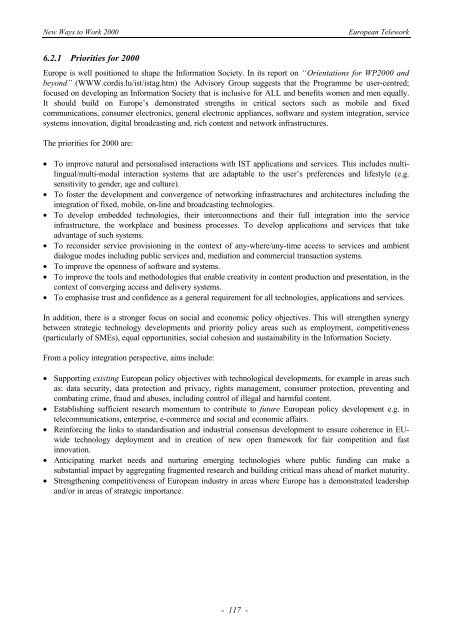eWORK 2000 - European Telework Week
eWORK 2000 - European Telework Week
eWORK 2000 - European Telework Week
- No tags were found...
You also want an ePaper? Increase the reach of your titles
YUMPU automatically turns print PDFs into web optimized ePapers that Google loves.
New Ways to Work <strong>2000</strong><strong>European</strong> <strong>Telework</strong>6.2.1 Priorities for <strong>2000</strong>Europe is well positioned to shape the Information Society. In its report on “Orientations for WP<strong>2000</strong> andbeyond” (WWW.cordis.lu/ist/istag.htm) the Advisory Group suggests that the Programme be user-centred;focused on developing an Information Society that is inclusive for ALL and benefits women and men equally.It should build on Europe’s demonstrated strengths in critical sectors such as mobile and fixedcommunications, consumer electronics, general electronic appliances, software and system integration, servicesystems innovation, digital broadcasting and, rich content and network infrastructures.The priorities for <strong>2000</strong> are:• To improve natural and personalised interactions with IST applications and services. This includes multilingual/multi-modalinteraction systems that are adaptable to the user’s preferences and lifestyle (e.g.sensitivity to gender, age and culture).• To foster the development and convergence of networking infrastructures and architectures including theintegration of fixed, mobile, on-line and broadcasting technologies.• To develop embedded technologies, their interconnections and their full integration into the serviceinfrastructure, the workplace and business processes. To develop applications and services that takeadvantage of such systems.• To reconsider service provisioning in the context of any-where/any-time access to services and ambientdialogue modes including public services and, mediation and commercial transaction systems.• To improve the openness of software and systems.• To improve the tools and methodologies that enable creativity in content production and presentation, in thecontext of converging access and delivery systems.• To emphasise trust and confidence as a general requirement for all technologies, applications and services.In addition, there is a stronger focus on social and economic policy objectives. This will strengthen synergybetween strategic technology developments and priority policy areas such as employment, competitiveness(particularly of SMEs), equal opportunities, social cohesion and sustainability in the Information Society.From a policy integration perspective, aims include:• Supporting existing <strong>European</strong> policy objectives with technological developments, for example in areas suchas: data security, data protection and privacy, rights management, consumer protection, preventing andcombating crime, fraud and abuses, including control of illegal and harmful content.• Establishing sufficient research momentum to contribute to future <strong>European</strong> policy development e.g. intelecommunications, enterprise, e-commerce and social and economic affairs.• Reinforcing the links to standardisation and industrial consensus development to ensure coherence in EUwidetechnology deployment and in creation of new open framework for fair competition and fastinnovation.• Anticipating market needs and nurturing emerging technologies where public funding can make asubstantial impact by aggregating fragmented research and building critical mass ahead of market maturity.• Strengthening competitiveness of <strong>European</strong> industry in areas where Europe has a demonstrated leadershipand/or in areas of strategic importance.- 117 -








